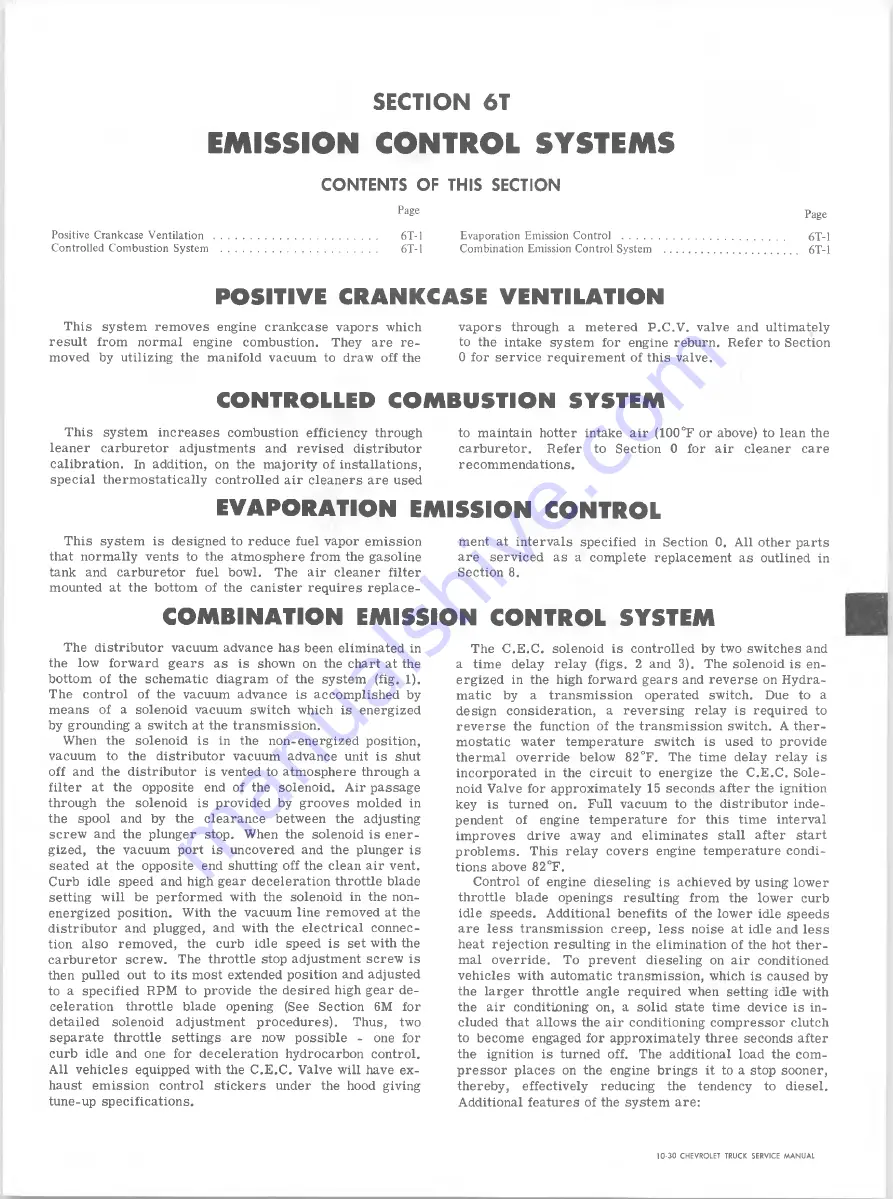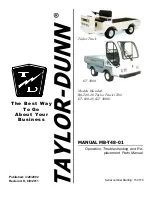
SECTION 6T
EMISSION CONTROL SYSTEMS
CONTENTS OF THIS SECTION
Positive Crankcase Ventilation ...........................................................
Evaporation Emission Control ..........................................................
Controlled Combustion System .....................................................
Combination Emission Control System ................................................ 6T-1
POSITIVE CRANKCASE VENTILATION
This system removes engine crankcase vapors which
result from normal engine combustion. They are re
moved by utilizing the manifold vacuum to draw off the
vapors through a metered P.C.V. valve and ultimately
to the intake system for engine reburn. Refer to Section
0 for service requirement of this valve.
CONTROLLED COMBUSTION SYSTEM
This system increases combustion efficiency through
leaner carburetor adjustments and revised distributor
calibration. In addition, on the majority of installations,
special thermostatically controlled air cleaners are used
to maintain hotter intake air (100°F or above) to lean the
carburetor. Refer to Section 0 for air cleaner care
recommendations.
EVAPORATION EMISSION CONTROL
This system is designed to reduce fuel vapor emission
that normally vents to the atmosphere from the gasoline
tank and carburetor fuel bowl. The air cleaner filter
mounted at the bottom of the canister requires replace
ment at intervals specified in Section 0. All other parts
are serviced as a complete replacement as outlined in
Section 8„
COMBINATION EMISSION CONTROL SYSTEM
The distributor vacuum advance has been eliminated in
the low forward gears as is shown on the chart at the
bottom of the schematic diagram of the system (fig. 1).
The control of the vacuum advance is accomplished by
means of a solenoid vacuum switch which is energized
by grounding a switch at the transmission.
When the solenoid is in the non-energized position,
vacuum to the distributor vacuum advance unit is shut
off and the distributor is vented to atmosphere through a
filter at the opposite end of the solenoid. Air passage
through the solenoid is provided by grooves molded in
the spool and by the clearance between the adjusting
screw and the plunger stop. When the solenoid is ener
gized, the vacuum port is uncovered and the plunger is
seated at the opposite end shutting off the clean air vent.
Curb idle speed and high gear deceleration throttle blade
setting will be performed with the solenoid in the non
energized position. With the vacuum line removed at the
distributor and plugged, and with the electrical connec
tion also removed, the curb idle speed is set with the
carburetor screw. The throttle stop adjustment screw is
then pulled out to its most extended position and adjusted
to a specified RPM to provide the desired high gear de
celeration throttle blade opening (See Section 6M for
detailed solenoid adjustment procedures). Thus, two
separate throttle settings are now possible - one for
curb idle and one for deceleration hydrocarbon control.
All vehicles equipped with the C.E.C. Valve will have ex
haust emission control stickers under the hood giving
tune-up specifications.
The C.E.C. solenoid is controlled by two switches and
a time delay relay (figs. 2 and 3). The solenoid is en
ergized in the high forward gears and reverse on Hydra-
matic by a transmission operated switch. Due to a
design consideration, a reversing relay is required to
reverse the function of the transmission switch. A ther
mostatic water temperature switch is used to provide
thermal override below 82 °F. The time delay relay is
incorporated in the circuit to energize the C.E.C. Sole
noid Valve for approximately 15 seconds after the ignition
key is turned on. Full vacuum to the distributor inde
pendent of engine temperature for this time interval
improves drive away and eliminates stall after start
problems. This relay covers engine temperature condi
tions above 82°F.
Control of engine dieseling is achieved by using lower
throttle blade openings resulting from the lower curb
idle speeds. Additional benefits of the lower idle speeds
are less transmission creep, less noise at idle and less
heat rejection resulting in the elimination of the hot ther
mal override. To prevent dieseling on air conditioned
vehicles with automatic transmission, which is caused by
the larger throttle angle required when setting idle with
the air conditioning on, a solid state time device is in
cluded that allows the air conditioning compressor clutch
to become engaged for approximately three seconds after
the ignition is turned off. The additional load the com
pressor places on the engine brings it to a stop sooner,
thereby, effectively reducing the tendency to diesel.
Additional features of the system are:
10-30 CHEVROLET TRUCK SERVICE MANUAL
Summary of Contents for 10 1971 Series
Page 1: ......
Page 96: ......
Page 100: ...10 30 CHEVROLET TRUCK SERVICE MANUAL Fig 4 10 30 Series Truck Frame FRAME 2 4 ...
Page 120: ......
Page 203: ...ENGINE 6 25 Fig 22L Engine Mounts 10 30 CHEVROLET TRUCK SERVICE MANUAL ...
Page 215: ...ENGINE 6 37 REAR M O U NT Fig 21V Engine Mounts 10 30 CHEVROLET TRUCK SERVICE MANUAL ...
Page 218: ......
Page 249: ......
Page 324: ......
Page 340: ......
Page 365: ...10 30 CHEVROLET TRUCK SERVICE MANUAL Fig 43 Power Steering Pump M ounting STEERING 9 25 ...
Page 368: ......
Page 386: ......
Page 390: ...ELECTRICAL BODY AND CHASSIS 12 4 10 30 CHEVROLET TRUCK SERVICE MANUAL ...
Page 391: ......
Page 428: ......
Page 432: ......
Page 449: ...SPECIFICATIONS 9 10 30 CHEVROLET TRUCK SERVICE MANUAL ...
Page 463: ......
Page 464: ......
Page 465: ......
Page 466: ......








































